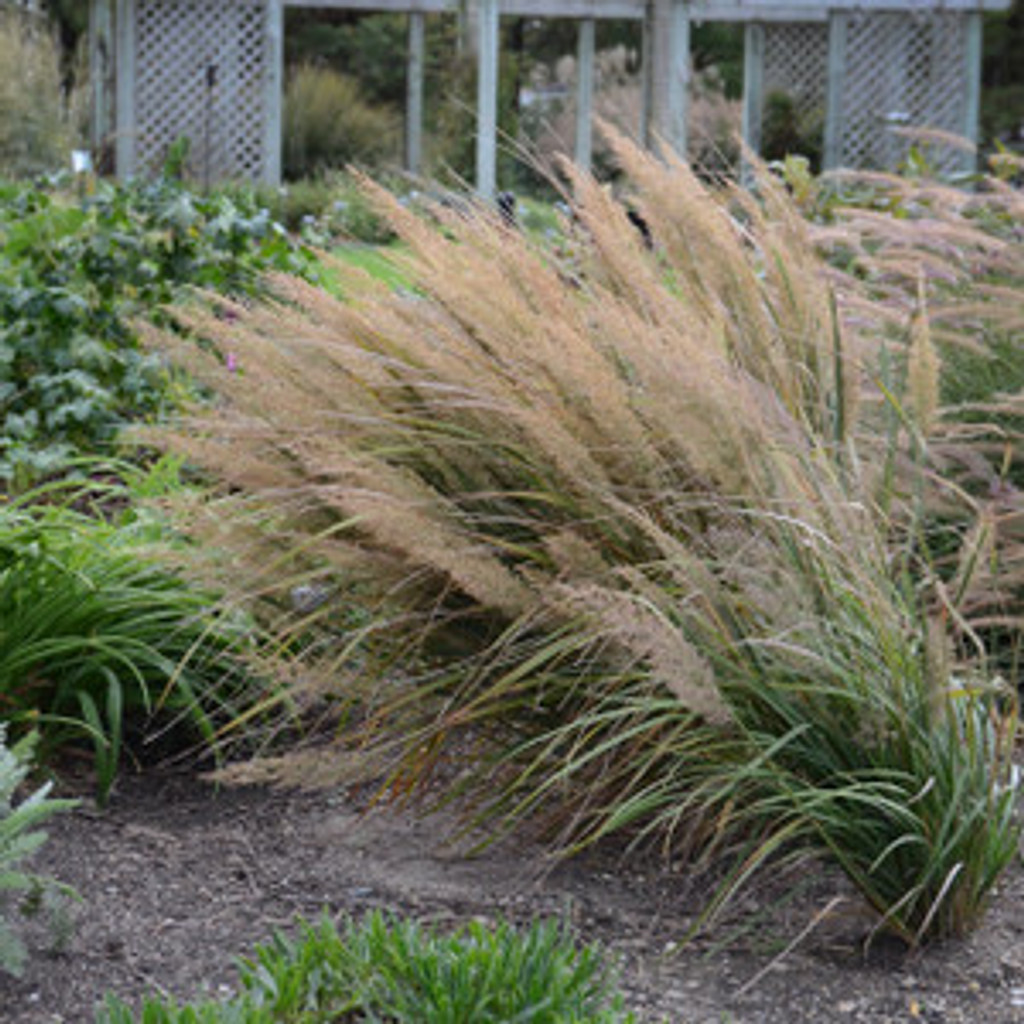
Feather Reed Grass
-
Green, White

Color
-
Spring

Season
-
3- 4 feet

Height
-
4-9

Zone
-
Bare Root/Plug

Ships
-
Full Sun

Exposure
Description
Description
Feather Reed Grass - bare root plug
Feathered Reed Grass, scientifically known as Calamagrostis acutiflora 'Karl Foerster,' is a popular ornamental grass cultivar in gardening and landscaping. It is known for its attractive, feathery plumes of flowers and its upright growth habit. Here are some key characteristics and information about Feathered Reed Grass:
- Appearance: Feathered Reed Grass typically grows in clumps and can reach 5 feet (0.9 to 1.5 meters) with a similar spread. The narrow, linear leaves are green and can have a graceful arching form.
- Flower Plumes: One of the main attractions of this grass is its feathery, pinkish-purple-to-tan flower plumes that appear in early summer and persist into the winter. These plumes sway in the breeze and add a sense of movement and elegance to the landscape.
- Growth Habit: Feathered Reed Grass is known for its upright and compact growth habit. It forms dense clumps that are well-behaved and do not spread aggressively, making it an excellent choice for borders, hedges, or as a specimen plant.
- Sun and Soil Requirements: This grass prefers full sun to light shade but will perform best in a sunny location. It can tolerate various soil types, but well-drained soil is essential for its health and longevity.
- Low Maintenance: Feathered Reed Grass is relatively low maintenance. It is drought-tolerant once established and can withstand a range of weather conditions. In late winter or early spring, you can cut back the old growth to make way for new growth.
- Wildlife Attraction: The feathery flower plumes of this grass can provide shelter and forage for birds.
- Landscape Uses: Feathered Reed Grass is commonly used in various landscape settings, such as mixed borders and mass plantings, and as a backdrop for other perennials and shrubs. It can also be used for erosion control on slopes.
'Karl Foerster' is one of the most well-known and widely grown varieties of Feathered Reed Grass, prized for its upright form and attractive flowers. It's a versatile and elegant choice for gardeners looking to add texture, structure, and visual interest to their landscapes.
Feathered reed grass (Calamagrostis x acutiflora 'Karl Foerster') is a popular ornamental grass known for its graceful, feathery plumes and low-maintenance nature. Here are some tips on how to take care of feathered reed grass:
- Planting:
- Feathered reed grass is adaptable to various soil types but thrives in fertile, well-draining soil.
- Watering:
- Water newly planted feathered reed grass regularly to help establish its roots. Once installed, it is relatively drought-tolerant and can handle some dry periods—water during extended dry spells to prevent from drying out .
- Pruning:
- In late winter or early spring, reduce the previous year's growth to about 4-6 inches above the ground. This encourages new growth and removes dead or damaged foliage. Be careful not to cut too low, as feathered reed grass starts growing from the base, and cutting too close to the ground may damage the plant.
- Fertilizing:
- Feathered reed grass generally only requires a little fertilization to promote healthy growth.
- Division:
- Every few years, divide the plant to maintain its health and vigor. Divide the grass in the early spring or late fall when it is dormant. Lift the clump, separate it into smaller sections, and replant them.
- Pests and Diseases:
- Feathered reed grass is relatively resistant to pests and diseases. Look for aphids and other common garden pests, and treat them as necessary.
- Mulch:
- Apply mulch around the grass to help retain moisture, suppress weeds, and regulate soil temperature. However, avoid mulching too close to the plant's crown to prevent rot.
- Winter Care:
- Feathered reed grass is generally hardy and can withstand cold winters. However, if you live in an area with harsh winters, you can leave the foliage intact for added protection during the colder months.
- Maintenance:
- Regularly remove dead or damaged growth and tidy up the grass to keep it looking neat and healthy.
- Enjoy the Plumes:
- One of the main attractions of feathered reed grass is its feathery plumes that appear in late spring or early summer. Enjoy these beautiful plumes as they sway in the breeze and add texture and interest to your garden.
Feathered reed grass is a low-maintenance and versatile plant that can add to your landscape. With proper care, it will provide year-round interest in your garden.
FAQ
1. Is Feather Reed Grass deer resistant?
A: Feather reed grass (Calamagrostis x acutiflora) is often considered to be deer resistant. Deer typically avoid plants with tough or sharp foliage, and feather reed grass fits this description with its narrow, upright leaves.
2. Does Feather Reed Grass survive winter?
A: In general, it is a hardy grass that can withstand winter conditions well. Feather Reed Grass is often used in landscaping and gardens for its upright and narrow form, and it adds interest to the winter landscape with its persistent seed heads.








